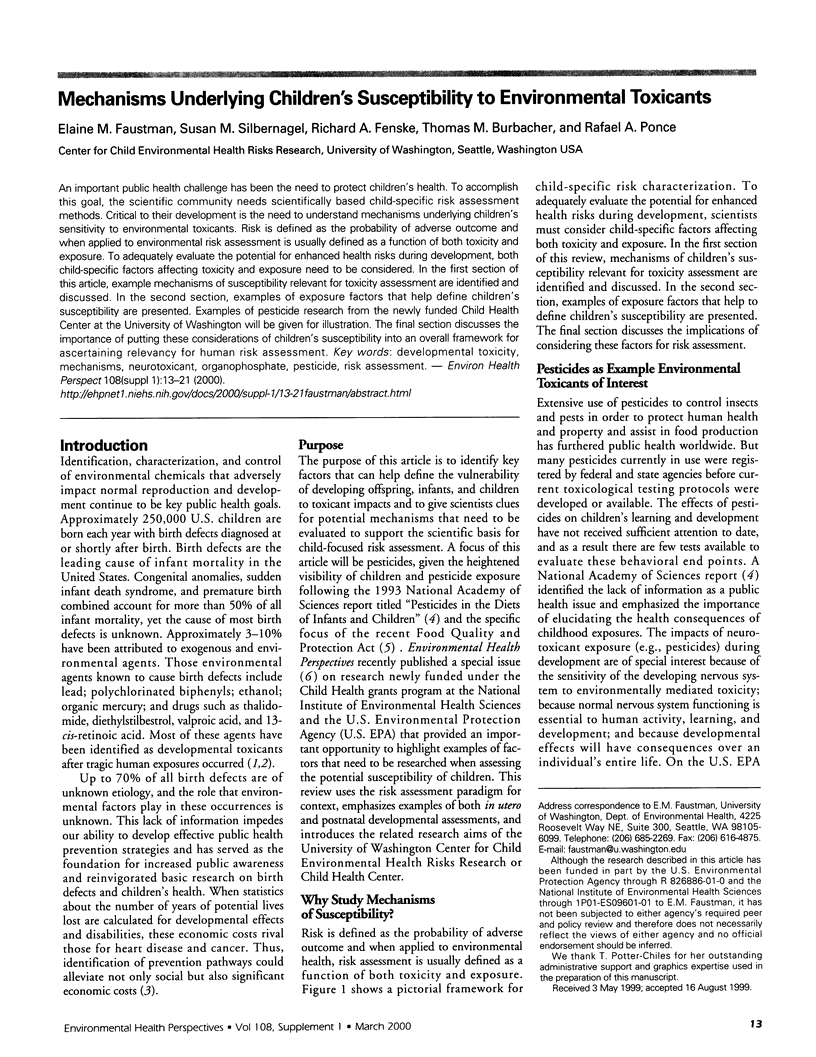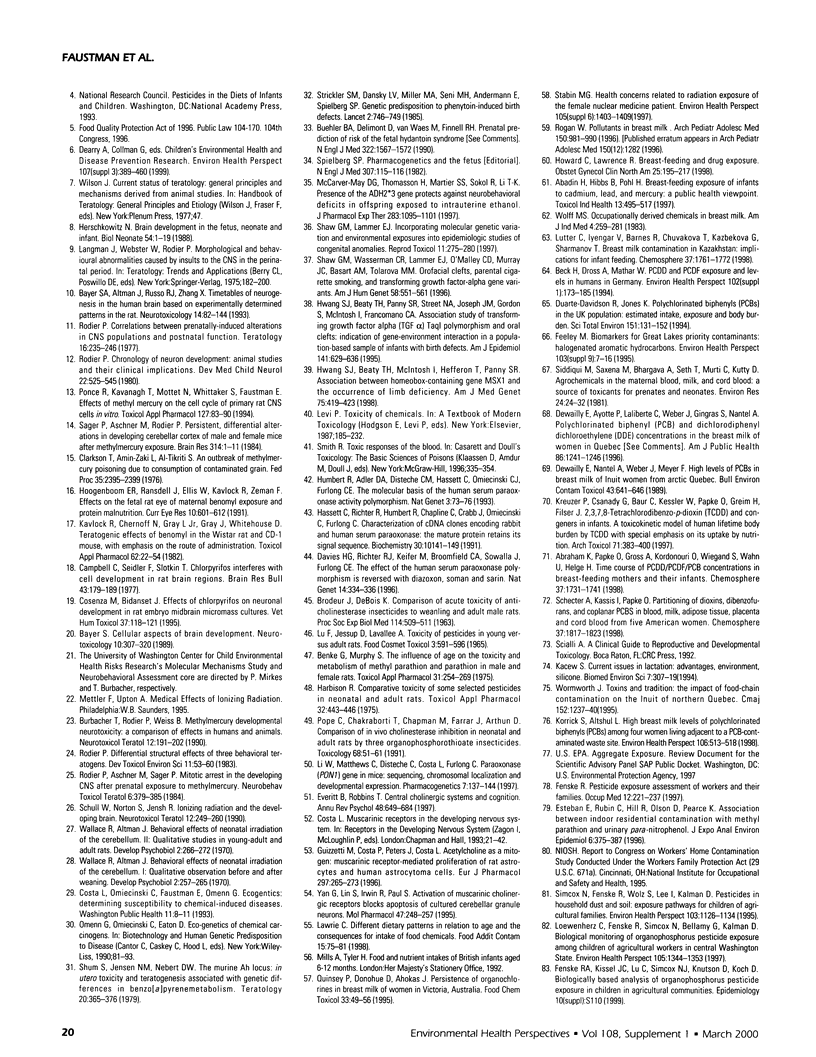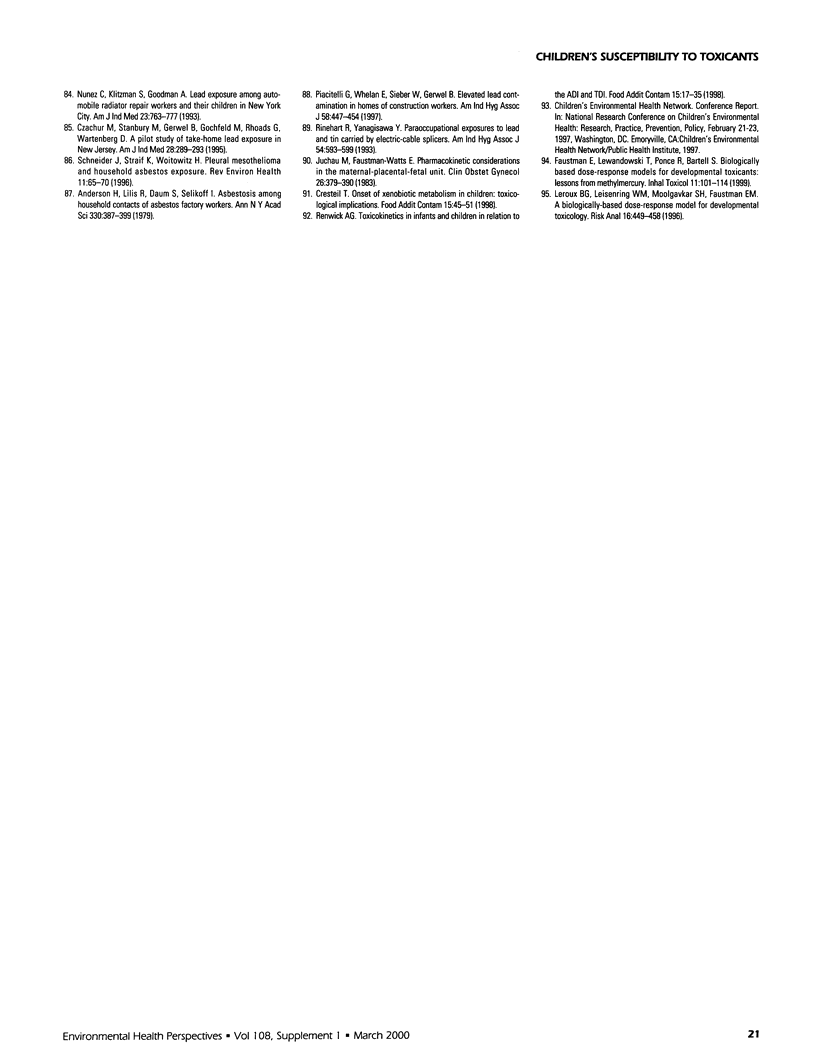Abstract
An important public health challenge has been the need to protect children's health. To accomplish this goal, the scientific community needs scientifically based child-specific risk assessment methods. Critical to their development is the need to understand mechanisms underlying children's sensitivity to environmental toxicants. Risk is defined as the probability of adverse outcome and when applied to environmental risk assessment is usually defined as a function of both toxicity and exposure. To adequately evaluate the potential for enhanced health risks during development, both child-specific factors affecting toxicity and exposure need to be considered. In the first section of this article, example mechanisms of susceptibility relevant for toxicity assessment are identified and discussed. In the second section, examples of exposure factors that help define children's susceptibility are presented. Examples of pesticide research from the newly funded Child Health Center at the University of Washington will be given for illustration. The final section discusses the importance of putting these considerations of children's susceptibility into an overall framework for ascertaining relevancy for human risk assessment.
Full text
PDF








Images in this article
Selected References
These references are in PubMed. This may not be the complete list of references from this article.
- Abadin H. G., Hibbs B. F., Pohl H. R. Breast-feeding exposure of infants to cadmium, lead, and mercury: a public health viewpoint. Toxicol Ind Health. 1997 Jul-Aug;13(4):495–517. doi: 10.1177/074823379701300403. [DOI] [PubMed] [Google Scholar]
- Abraham K., Päpke O., Gross A., Kordonouri O., Wiegand S., Wahn U., Helge H. Time course of PCDD/PCDF/PCB concentrations in breast-feeding mothers and their infants. Chemosphere. 1998 Oct-Nov;37(9-12):1731–1741. doi: 10.1016/s0045-6535(98)00238-0. [DOI] [PubMed] [Google Scholar]
- Anderson H. A., Lilis R., Daum S. M., Selikoff I. J. Asbestosis among household contacts of asbestos factory workers. Ann N Y Acad Sci. 1979;330:387–399. doi: 10.1111/j.1749-6632.1979.tb18741.x. [DOI] [PubMed] [Google Scholar]
- BRODEUR J., DUBOIS K. P. COMPARISON OF ACUTE TOXICITY OF ANTICHOLINESTERASE INSECTICIDES TO WEANLING AND ADULT MALE RATS. Proc Soc Exp Biol Med. 1963 Nov;114:509–511. doi: 10.3181/00379727-114-28716. [DOI] [PubMed] [Google Scholar]
- Bayer S. A., Altman J., Russo R. J., Zhang X. Timetables of neurogenesis in the human brain based on experimentally determined patterns in the rat. Neurotoxicology. 1993 Spring;14(1):83–144. [PubMed] [Google Scholar]
- Bayer S. A. Cellular aspects of brain development. Neurotoxicology. 1989 Fall;10(3):307–320. [PubMed] [Google Scholar]
- Beck H., Dross A., Mathar W. PCDD and PCDF exposure and levels in humans in Germany. Environ Health Perspect. 1994 Jan;102 (Suppl 1):173–185. doi: 10.1289/ehp.94102s1173. [DOI] [PMC free article] [PubMed] [Google Scholar]
- Benke G. M., Murphy S. D. The influence of age on the toxicity and metabolism of methyl parathion and parathion in male and female rats. Toxicol Appl Pharmacol. 1975 Feb;31(2):254–269. doi: 10.1016/0041-008x(75)90161-1. [DOI] [PubMed] [Google Scholar]
- Buehler B. A., Delimont D., van Waes M., Finnell R. H. Prenatal prediction of risk of the fetal hydantoin syndrome. N Engl J Med. 1990 May 31;322(22):1567–1572. doi: 10.1056/NEJM199005313222204. [DOI] [PubMed] [Google Scholar]
- Burbacher T. M., Rodier P. M., Weiss B. Methylmercury developmental neurotoxicity: a comparison of effects in humans and animals. Neurotoxicol Teratol. 1990 May-Jun;12(3):191–202. doi: 10.1016/0892-0362(90)90091-p. [DOI] [PubMed] [Google Scholar]
- Campbell C. G., Seidler F. J., Slotkin T. A. Chlorpyrifos interferes with cell development in rat brain regions. Brain Res Bull. 1997;43(2):179–189. doi: 10.1016/s0361-9230(96)00436-4. [DOI] [PubMed] [Google Scholar]
- Clarkson T. W., Amin-Zaki L., Al-Tikriti S. K. An outbreak of methylmercury poisoning due to consumption of contaminated grain. Fed Proc. 1976 Oct;35(12):2395–2399. [PubMed] [Google Scholar]
- Cosenza M. E., Bidanset J. Effects of chlorpyrifos on neuronal development in rat embryo midbrain micromass cultures. Vet Hum Toxicol. 1995 Apr;37(2):118–121. [PubMed] [Google Scholar]
- Cresteil T. Onset of xenobiotic metabolism in children: toxicological implications. Food Addit Contam. 1998;15 (Suppl):45–51. doi: 10.1080/02652039809374614. [DOI] [PubMed] [Google Scholar]
- Czachur M., Stanbury M., Gerwel B., Gochfeld M., Rhoads G. G., Wartenberg D. A pilot study of take-home lead exposure in New Jersey. Am J Ind Med. 1995 Aug;28(2):289–293. doi: 10.1002/ajim.4700280213. [DOI] [PubMed] [Google Scholar]
- Davies H. G., Richter R. J., Keifer M., Broomfield C. A., Sowalla J., Furlong C. E. The effect of the human serum paraoxonase polymorphism is reversed with diazoxon, soman and sarin. Nat Genet. 1996 Nov;14(3):334–336. doi: 10.1038/ng1196-334. [DOI] [PubMed] [Google Scholar]
- Dewailly E., Ayotte P., Laliberté C., Weber J. P., Gingras S., Nantel A. J. Polychlorinated biphenyl (PCB) and dichlorodiphenyl dichloroethylene (DDE) concentrations in the breast milk of women in Quebec. Am J Public Health. 1996 Sep;86(9):1241–1246. doi: 10.2105/ajph.86.9.1241. [DOI] [PMC free article] [PubMed] [Google Scholar]
- Dewailly E., Nantel A., Weber J. P., Meyer F. High levels of PCBs in breast milk of Inuit women from arctic Quebec. Bull Environ Contam Toxicol. 1989 Nov;43(5):641–646. doi: 10.1007/BF01701981. [DOI] [PubMed] [Google Scholar]
- Duarte-Davidson R., Jones K. C. Polychlorinated biphenyls (PCBs) in the UK population: estimated intake, exposure and body burden. Sci Total Environ. 1994 Jul 11;151(2):131–152. doi: 10.1016/0048-9697(94)90170-8. [DOI] [PubMed] [Google Scholar]
- Esteban E., Rubin C., Hill R., Olson D., Pearce K. Association between indoor residential contamination with methyl parathion and urinary para-nitrophenol. J Expo Anal Environ Epidemiol. 1996 Jul-Sep;6(3):375–387. [PubMed] [Google Scholar]
- Everitt B. J., Robbins T. W. Central cholinergic systems and cognition. Annu Rev Psychol. 1997;48:649–684. doi: 10.1146/annurev.psych.48.1.649. [DOI] [PubMed] [Google Scholar]
- Feeley M. M. Biomarkers for Great Lakes priority contaminants: halogenated aromatic hydrocarbons. Environ Health Perspect. 1995 Dec;103 (Suppl 9):7–16. doi: 10.1289/ehp.95103s97. [DOI] [PMC free article] [PubMed] [Google Scholar]
- Fenske R. A. Pesticide exposure assessment of workers and their families. Occup Med. 1997 Apr-Jun;12(2):221–237. [PubMed] [Google Scholar]
- Guizzetti M., Costa P., Peters J., Costa L. G. Acetylcholine as a mitogen: muscarinic receptor-mediated proliferation of rat astrocytes and human astrocytoma cells. Eur J Pharmacol. 1996 Feb 22;297(3):265–273. doi: 10.1016/0014-2999(95)00746-6. [DOI] [PubMed] [Google Scholar]
- Harbison R. D. Comparative toxicity of some selected pesticides in neonatal and adult rats. Toxicol Appl Pharmacol. 1975 May;32(2):443–446. doi: 10.1016/0041-008x(75)90234-3. [DOI] [PubMed] [Google Scholar]
- Hassett C., Richter R. J., Humbert R., Chapline C., Crabb J. W., Omiecinski C. J., Furlong C. E. Characterization of cDNA clones encoding rabbit and human serum paraoxonase: the mature protein retains its signal sequence. Biochemistry. 1991 Oct 22;30(42):10141–10149. doi: 10.1021/bi00106a010. [DOI] [PubMed] [Google Scholar]
- Herschkowitz N. Brain development in the fetus, neonate and infant. Biol Neonate. 1988;54(1):1–19. doi: 10.1159/000242818. [DOI] [PubMed] [Google Scholar]
- Hoogenboom E. R., Ransdell J. F., Ellis W. G., Kavlock R. J., Zeman F. J. Effects on the fetal rat eye of maternal benomyl exposure and protein malnutrition. Curr Eye Res. 1991 Jul;10(7):601–612. doi: 10.3109/02713689109013852. [DOI] [PubMed] [Google Scholar]
- Howard C. R., Lawrence R. A. Breast-feeding and drug exposure. Obstet Gynecol Clin North Am. 1998 Mar;25(1):195–217. doi: 10.1016/s0889-8545(05)70365-x. [DOI] [PubMed] [Google Scholar]
- Humbert R., Adler D. A., Disteche C. M., Hassett C., Omiecinski C. J., Furlong C. E. The molecular basis of the human serum paraoxonase activity polymorphism. Nat Genet. 1993 Jan;3(1):73–76. doi: 10.1038/ng0193-73. [DOI] [PubMed] [Google Scholar]
- Hwang S. J., Beaty T. H., McIntosh I., Hefferon T., Panny S. R. Association between homeobox-containing gene MSX1 and the occurrence of limb deficiency. Am J Med Genet. 1998 Feb 3;75(4):419–423. [PubMed] [Google Scholar]
- Hwang S. J., Beaty T. H., Panny S. R., Street N. A., Joseph J. M., Gordon S., McIntosh I., Francomano C. A. Association study of transforming growth factor alpha (TGF alpha) TaqI polymorphism and oral clefts: indication of gene-environment interaction in a population-based sample of infants with birth defects. Am J Epidemiol. 1995 Apr 1;141(7):629–636. doi: 10.1093/oxfordjournals.aje.a117478. [DOI] [PubMed] [Google Scholar]
- Juchau M. R., Faustman-Watts E. Pharmacokinetic considerations in the maternal-placental-fetal unit. Clin Obstet Gynecol. 1983 Jun;26(2):379–390. doi: 10.1097/00003081-198306000-00020. [DOI] [PubMed] [Google Scholar]
- Kacew S. Current issues in lactation: advantages, environment, silicone. Biomed Environ Sci. 1994 Dec;7(4):307–319. [PubMed] [Google Scholar]
- Kavlock R. J., Chernoff N., Gray L. E., Jr, Gray J. A., Whitehouse D. Teratogenic effects of benomyl in the Wistar rat and CD-1 mouse, with emphasis on the route of administration. Toxicol Appl Pharmacol. 1982 Jan;62(1):44–54. doi: 10.1016/0041-008x(82)90100-4. [DOI] [PubMed] [Google Scholar]
- Korrick S. A., Altshul L. High breast milk levels of polychlorinated biphenyls (PCBs) among four women living adjacent to a PCB-contaminated waste site. Environ Health Perspect. 1998 Aug;106(8):513–518. doi: 10.1289/ehp.98106513. [DOI] [PMC free article] [PubMed] [Google Scholar]
- Kreuzer P. E., Csanády G. A., Baur C., Kessler W., Päpke O., Greim H., Filser J. G. 2,3,7,8-Tetrachlorodibenzo-p-dioxin (TCDD) and congeners in infants. A toxicokinetic model of human lifetime body burden by TCDD with special emphasis on its uptake by nutrition. Arch Toxicol. 1997;71(6):383–400. doi: 10.1007/s002040050402. [DOI] [PubMed] [Google Scholar]
- Lawrie C. A. Different dietary patterns in relation to age and the consequences for intake of food chemicals. Food Addit Contam. 1998;15 (Suppl):75–81. doi: 10.1080/02652039809374618. [DOI] [PubMed] [Google Scholar]
- Leroux B. G., Leisenring W. M., Moolgavkar S. H., Faustman E. M. A biologically-based dose-response model for developmental toxicology. Risk Anal. 1996 Aug;16(4):449–458. doi: 10.1111/j.1539-6924.1996.tb01092.x. [DOI] [PubMed] [Google Scholar]
- Li W. F., Matthews C., Disteche C. M., Costa L. G., Furlong C. E. Paraoxonase (PON1) gene in mice: sequencing, chromosomal localization and developmental expression. Pharmacogenetics. 1997 Apr;7(2):137–144. doi: 10.1097/00008571-199704000-00007. [DOI] [PubMed] [Google Scholar]
- Loewenherz C., Fenske R. A., Simcox N. J., Bellamy G., Kalman D. Biological monitoring of organophosphorus pesticide exposure among children of agricultural workers in central Washington State. Environ Health Perspect. 1997 Dec;105(12):1344–1353. doi: 10.1289/ehp.971051344. [DOI] [PMC free article] [PubMed] [Google Scholar]
- Lu F. C., Jessup D. C., Lavallée A. Toxicity of pesticides in young versus adult rats. Food Cosmet Toxicol. 1965 Oct;3(4):591–596. doi: 10.1016/s0015-6264(65)80206-1. [DOI] [PubMed] [Google Scholar]
- Lutter C., Iyengar V., Barnes R., Chuvakova T., Kazbekova G., Sharmanov T. Breast milk contamination in Kazakhstan: implications for infant feeding. Chemosphere. 1998 Oct-Nov;37(9-12):1761–1772. doi: 10.1016/s0045-6535(98)00241-0. [DOI] [PubMed] [Google Scholar]
- McCarver D. G., Thomasson H. R., Martier S. S., Sokol R. J., Li T. Alcohol dehydrogenase-2*3 allele protects against alcohol-related birth defects among African Americans. J Pharmacol Exp Ther. 1997 Dec;283(3):1095–1101. [PubMed] [Google Scholar]
- Nunez C. M., Klitzman S., Goodman A. Lead exposure among automobile radiator repair workers and their children in New York City. Am J Ind Med. 1993 May;23(5):763–777. doi: 10.1002/ajim.4700230510. [DOI] [PubMed] [Google Scholar]
- Piacitelli G. M., Whelan E. A., Sieber W. K., Gerwel B. Elevated lead contamination in homes of construction workers. Am Ind Hyg Assoc J. 1997 Jun;58(6):447–454. doi: 10.1080/15428119791012694. [DOI] [PubMed] [Google Scholar]
- Ponce R. A., Kavanagh T. J., Mottet N. K., Whittaker S. G., Faustman E. M. Effects of methyl mercury on the cell cycle of primary rat CNS cells in vitro. Toxicol Appl Pharmacol. 1994 Jul;127(1):83–90. doi: 10.1006/taap.1994.1142. [DOI] [PubMed] [Google Scholar]
- Pope C. N., Chakraborti T. K., Chapman M. L., Farrar J. D., Arthun D. Comparison of in vivo cholinesterase inhibition in neonatal and adult rats by three organophosphorothioate insecticides. Toxicology. 1991;68(1):51–61. doi: 10.1016/0300-483x(91)90061-5. [DOI] [PubMed] [Google Scholar]
- Renwick A. G. Toxicokinetics in infants and children in relation to the ADI and TDI. Food Addit Contam. 1998;15 (Suppl):17–35. doi: 10.1080/02652039809374612. [DOI] [PubMed] [Google Scholar]
- Rinehart R. D., Yanagisawa Y. Paraoccupational exposures to lead and tin carried by electric-cable splicers. Am Ind Hyg Assoc J. 1993 Oct;54(10):593–599. doi: 10.1080/15298669391355107. [DOI] [PubMed] [Google Scholar]
- Rodier P. M., Aschner M., Sager P. R. Mitotic arrest in the developing CNS after prenatal exposure to methylmercury. Neurobehav Toxicol Teratol. 1984 Sep-Oct;6(5):379–385. [PubMed] [Google Scholar]
- Rodier P. M. Chronology of neuron development: animal studies and their clinical implications. Dev Med Child Neurol. 1980 Aug;22(4):525–545. doi: 10.1111/j.1469-8749.1980.tb04363.x. [DOI] [PubMed] [Google Scholar]
- Rodier P. M. Correlations between prenatally-induced alterations in CNS cell populations and postnatal function. Teratology. 1977 Oct;16(2):235–246. doi: 10.1002/tera.1420160220. [DOI] [PubMed] [Google Scholar]
- Rodier P. M. Differential structural effects of three behavioral teratogens. Dev Toxicol Environ Sci. 1983;11:53–60. [PubMed] [Google Scholar]
- Rogan W. J. Pollutants in breast milk. Arch Pediatr Adolesc Med. 1996 Sep;150(9):981–990. doi: 10.1001/archpedi.1996.02170340095018. [DOI] [PubMed] [Google Scholar]
- Sager P. R., Aschner M., Rodier P. M. Persistent, differential alterations in developing cerebellar cortex of male and female mice after methylmercury exposure. Brain Res. 1984 Jan;314(1):1–11. doi: 10.1016/0165-3806(84)90170-6. [DOI] [PubMed] [Google Scholar]
- Schecter A., Kassis I., Päpke O. Partitioning of dioxins, dibenzofurans, and coplanar PCBS in blood, milk, adipose tissue, placenta and cord blood from five American women. Chemosphere. 1998 Oct-Nov;37(9-12):1817–1823. doi: 10.1016/s0045-6535(98)00247-1. [DOI] [PubMed] [Google Scholar]
- Schneider J., Straif K., Woitowitz H. J. Pleural mesothelioma and household asbestos exposure. Rev Environ Health. 1996 Jan-Jun;11(1-2):65–70. doi: 10.1515/reveh.1996.11.1-2.65. [DOI] [PubMed] [Google Scholar]
- Schull W. J., Norton S., Jensh R. P. Ionizing radiation and the developing brain. Neurotoxicol Teratol. 1990 May-Jun;12(3):249–260. doi: 10.1016/0892-0362(90)90096-u. [DOI] [PubMed] [Google Scholar]
- Shaw G. M., Lammer E. J. Incorporating molecular genetic variation and environmental exposures into epidemiologic studies of congenital anomalies. Reprod Toxicol. 1997 Mar-Jun;11(2-3):275–280. doi: 10.1016/s0890-6238(96)00145-1. [DOI] [PubMed] [Google Scholar]
- Shaw G. M., Wasserman C. R., Lammer E. J., O'Malley C. D., Murray J. C., Basart A. M., Tolarova M. M. Orofacial clefts, parental cigarette smoking, and transforming growth factor-alpha gene variants. Am J Hum Genet. 1996 Mar;58(3):551–561. [PMC free article] [PubMed] [Google Scholar]
- Shum S., Jensen N. M., Nebert D. W. The murine Ah locus: in utero toxicity and teratogenesis associated with genetic differences in benzo[a]pyrene metabolism. Teratology. 1979 Dec;20(3):365–376. doi: 10.1002/tera.1420200307. [DOI] [PubMed] [Google Scholar]
- Siddiqui M. K., Saxena M. C., Bhargava A. K., Seth T. D., Murti C. R., Kutty D. Agrochemicals in the maternal blood, milk, and cord blood: a source of toxicants for prenates and neonates. Environ Res. 1981 Feb;24(1):24–32. doi: 10.1016/0013-9351(81)90128-6. [DOI] [PubMed] [Google Scholar]
- Simcox N. J., Fenske R. A., Wolz S. A., Lee I. C., Kalman D. A. Pesticides in household dust and soil: exposure pathways for children of agricultural families. Environ Health Perspect. 1995 Dec;103(12):1126–1134. doi: 10.1289/ehp.951031126. [DOI] [PMC free article] [PubMed] [Google Scholar]
- Spielberg S. P. Pharmacogenetics and the fetus. N Engl J Med. 1982 Jul 8;307(2):115–116. doi: 10.1056/NEJM198207083070210. [DOI] [PubMed] [Google Scholar]
- Stabin M. G. Health concerns related to radiation exposure of the female nuclear medicine patient. Environ Health Perspect. 1997 Dec;105 (Suppl 6):1403–1409. doi: 10.1289/ehp.97105s61403. [DOI] [PMC free article] [PubMed] [Google Scholar]
- Strickler S. M., Dansky L. V., Miller M. A., Seni M. H., Andermann E., Spielberg S. P. Genetic predisposition to phenytoin-induced birth defects. Lancet. 1985 Oct 5;2(8458):746–749. doi: 10.1016/s0140-6736(85)90629-4. [DOI] [PubMed] [Google Scholar]
- Wallace R. B., Altman J. Behavioral effects of neonatal irradiation of the cerebellum. I. Qualitative observations in infant and adolescent rats. Dev Psychobiol. 1970;2(4):257–265. doi: 10.1002/dev.420020411. [DOI] [PubMed] [Google Scholar]
- Wallace R. B., Altman J. Behavioral effects of neonatal irradiation of the cerebellum. II. Quantitative studies in young-adult and adult rats. Dev Psychobiol. 1970;2(4):266–272. doi: 10.1002/dev.420020412. [DOI] [PubMed] [Google Scholar]
- Wolff M. S. Occupationally derived chemicals in breast milk. Am J Ind Med. 1983;4(1-2):259–281. [PubMed] [Google Scholar]
- Wormworth J. Toxins and tradition: the impact of food-chain contamination on the Inuit of northern Quebec. CMAJ. 1995 Apr 15;152(8):1237–1240. [PMC free article] [PubMed] [Google Scholar]
- Yan G. M., Lin S. Z., Irwin R. P., Paul S. M. Activation of muscarinic cholinergic receptors blocks apoptosis of cultured cerebellar granule neurons. Mol Pharmacol. 1995 Feb;47(2):248–257. [PubMed] [Google Scholar]







